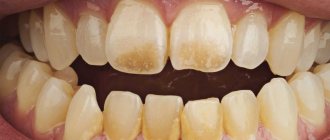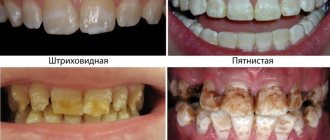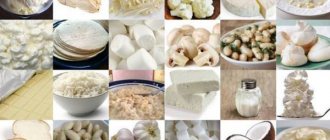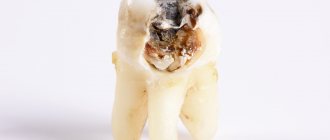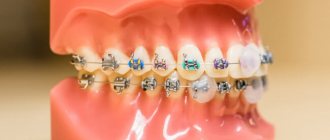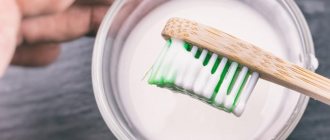What determines the color of teeth
It is believed that the color of the enamel determines the color of a person’s teeth, but in fact this is not entirely true. Tooth enamel can be milky white and translucent. Initially, in young people, it is quite dense and almost does not show through the underlying dentin, which in turn has a yellow, grayish or yellow-brown tint. The thicker the enamel, the whiter the teeth. The converse is also true.
Over the course of a person's life, the enamel becomes thinner and the color of the dentin appears. Hence the yellow or grayish smiles of older people. Food, drinks and tobacco also contribute to the darkening of teeth. Don’t forget about dental plaque and tartar, which absorb pigments much more strongly than enamel due to their porous structure.
A sudden change in the color of one or more teeth may indicate the presence of a disease. Thus, with fluorosis, teeth may acquire a brownish tint with whitish spots or stripes. Gray color occurs in pulpless teeth or may indicate heavy metal poisoning.
Internal reasons
Changing the color of teeth is not always due to external reasons. Sometimes the enamel changes shade, even if you follow a “transparent diet”, stop smoking and devote a lot of time to hygiene procedures. Darkening may be due to:
- With genetic diseases.
- With dental injuries that are accompanied by damage to the pulp. Hemorrhage causes the color to change from the inside.
- Using some filling materials.
- With nerve removal (depulpation).
- With diseases of the gastrointestinal tract.
- With an imbalance of fluoride in the body. With a deficiency of the mineral, the enamel darkens; with an excess, on the contrary, light spots appear.
- With metabolic disorders and disruptions in the endocrine system.
- With taking certain medications. Chemotherapy often causes darkening of the enamel.
- With radiation therapy. Sometimes, as a result of this treatment, the composition of the saliva changes, which leads to a change in color.
- With the aging of the body. With age, bone tissue density changes, teeth wear out faster, and their color becomes dull and yellowish.
In such situations, neither hygiene nor avoidance of colored foods will help. It is necessary to treat the underlying disease that led to the color change. You should not try to solve the problem yourself. The dentist will find out why the tooth enamel changes color and tell you how to get rid of this defect. Today there are many ways to safely whiten.
Popular questions
Will dead teeth whiten?
To change the shade of pulpless teeth, special techniques are used, such as intracanal bleaching. From the name it is clear that the brightening composition is applied not only from the outside, but also from the inside. To do this, the existing filling is removed, and the space where the pulp used to be is filled with gel with hydrogen peroxide. When the shade changes, the gel is removed and the cavity is filled.
If you stop drinking coffee, will your teeth become lighter?
If you stop drinking coffee, the color will not get darker. In order for the enamel to become lighter, you must first carry out professional cleaning and whitening, and then give up coffee.
How to keep your teeth white
To keep your teeth white, you need to:
- Perform good oral hygiene, including brushing, flossing, and using mouth rinse
- Using a waterpik at least twice a week to get rid of plaque
- Once or twice a year, have your mouth professionally cleaned by a dental hygienist to remove tartar.
- Limit or eliminate smoking, strong tea and coffee
It is also important to make regular visits to the dentist for diagnostic procedures. This will allow timely identification of problems and identification of deterioration of the enamel.
Types of plaque on teeth
The plaque can be of different colors - brown, white, cream, yellowish, gray and even black. Each case is considered separately, since it may indicate the presence of certain pathologies.
White, cream, yellowish. It is detected due to eating disorders and poor hygiene. Forms while the baby sleeps. Consists of food debris, bacteria, epithelium. Regular hygiene will help eliminate the problem.
Grey. Develops with enamel hypoplasia. This is the name of a condition in which the structure and mineralization of dental tissues are disturbed. Treatment is selected by the doctor taking into account the degree of pathology. It is unlikely that you will be able to remove such plaque on your own.
Teeth whitening and restoration techniques
If even careful care and regular professional hygiene do not allow you to completely get rid of yellowness, teeth whitening comes to the rescue. In our articles, we have already examined in detail the advantages and disadvantages of office and home whitening.
When darkening of the teeth is caused by severe thinning of the enamel, dental disease, or a general deterioration in the patient’s health, the first step is to correctly diagnose the problem and carry out appropriate treatment. Afterwards, it is possible to restore your smile with the help of veneers, lumineers and crowns.
We recommend that you try your best to keep your teeth healthy.
Causes of plaque on teeth
Plaque is a common phenomenon, but not everyone knows why it accumulates or how to avoid it. It itself is an accumulation of food debris mixed with bacteria and epithelial cells. They gradually settle in subgingival pockets, on teeth, in the interdental space.
While there are few clusters, they are invisible, there is no threat. When there is no regular hygiene, plaque becomes an environment for the spread of harmful microorganisms that negatively affect the enamel.
The causes of plaque on the teeth of children 1-5 years old will be:
- individual composition of saliva,
- fungal infections,
- dysbacteriosis,
- sweet drinks from a bottle,
- incorrect choice of hygiene products, irregular cleaning,
- soft food not suitable for age,
- malocclusion, bad teeth,
- bile duct diseases.
Why does plaque form?
Plaque is the deposition of components of saliva, food debris, various microorganisms and their metabolic products on the tooth enamel. At first, all of the listed components accumulate in places that are not easy to reach with a brush. Most often this occurs in the cervical area or fissures.
Deposits are formed in three stages:
- Pellicle formation. This is an ultra-thin cell-free film consisting of proteins that make up saliva.
- Attachment of opportunistic agents. The pellicles are retained on the membrane and streptococci and other microorganisms remain. Their reproduction and waste products cause plaque thickening.
- The composition of the accumulations changes to anaerobic. Plaque is not washed off with saliva and cannot be removed even by rinsing. Gradually this leads to demineralization of the enamel.
In normal conditions, thin plaque on the teeth of a child or adult forms during the day. Complete oral care can eliminate it.
If hygiene is not carried out correctly, and some predisposing factors appear, the pellicle and the bacteria on it are not removed. The plaque hardens and thickens. Subsequently, the color of the teeth also changes.
Predisposing factors include:
- Nutritional features. Eating mostly soft foods. And also an excess of sweets.
- Mechanical food processing. The manner of chewing food on only one side leads to the appearance of plaque on the opposite side.
- Lack or lack of hygiene.
- Changes in pH levels in the oral cavity.
How quickly plaque will form largely depends on the viscosity of saliva, as well as on the rate of desquamation of the epithelium and the presence of inflammatory processes in the oral cavity. Hardening of plaque ends with the formation of tartar.
Painting enamel light gray
Gray plaque on a child’s teeth can quickly destroy the enamel. It creates roughness and causes an unpleasant odor. Caries in children begins to progress rapidly.
Gray plaque in adults usually does not pose such a danger. Firstly, because enamel is much stronger. And secondly, gray plaque most often forms in adults due to smoking and drinking coloring drinks, such as coffee, tea and red wine. That is, the enamel is not damaged, but stained.
The appearance of gray plaque in a child can be caused by hypoplasia. It is impossible to get rid of this pathology, which is associated with impaired mineralization, on your own. Only a qualified dentist can select adequate treatment. Unfortunately, bleaching will not help here. It can only make the situation worse. The dentist will recommend procedures to remineralize the enamel.
White coating
White plaque appears on a child's teeth most often. It belongs to the soft category and does not pose a danger to enamel. Its formation occurs gradually. It is usually completely removed with minimal mechanical impact.
White plaque can appear at any age. But it is more common in children of the first year of life. Such plaque is nothing more than the remains of breast milk or formula. Food particles mix with epithelial cells and bacteria. All this forms a sticky film that covers the baby's teeth.
If a child has white plaque on his teeth, he must remove it himself. Otherwise, it will begin to harden, and it will be impossible to do without the help of a dentist.
You can remove the plaque with a piece of gauze moistened with warm water. Then it is recommended to purchase a special silicone brush that mom or dad can put on their finger and brush the little one’s teeth. From six months you can use special baby pastes that you can swallow. For one procedure you will need no more than half a pea of the product.
Brown coating
Brown plaque on the teeth of a child under two years of age is a harbinger of bottle caries. Most often, it affects babies who are given sweet tea or juice to drink instead of water at night. And also those children who are bottle-fed for a long time.
The enamel of one-year-old babies is too delicate. Sweet foods are an excellent environment for the development of various bacteria. Tooth decay occurs very quickly.
Caries is far from the only factor that provokes the appearance of brown plaque on a child’s teeth. The reasons may be the following:
- Taking iron supplements. Children with anemia are often prescribed similar medications. Their use in most cases leads to the appearance of a brown coating. It is mechanically impossible to remove it. It will disappear on its own some time after you stop taking the drug.
- Eating food with dyes. Beets, blueberries, carrots and many other foods with pigment can lead to the formation of dark plaque on a child’s teeth. All that is required to remove it is normal hygienic cleaning.
You should only seek help from a dentist if the cause of brown spots is caries. Many parents are in no hurry to take their child to the doctor because they do not want to cause stress to their child. They are confident that replacing a damaged baby tooth with a permanent one will solve all problems.
Unfortunately, this opinion is wrong. Deep caries of primary teeth can infect already growing permanent ones. Therefore, for the sake of health and a beautiful smile in the future, at the first alarming symptoms, you must seek help from a doctor. The dentist will provide the necessary treatment. After that, be sure to cover your teeth with a protective solution containing fluoride.
Yellow plaque
Yellow plaque on a child’s teeth provokes the development of caries much faster than in an adult. The enamel of babies is much thinner. Therefore, the yellow tint of a child’s teeth should be a signal for parents to take action.
Light yellow spots in children under one year of age may appear due to plaque, injury or caries. And also due to problems with intrauterine development. Dental buds can be affected even during pregnancy, at the stage of their formation.
Humidity plays an important role in the room where the child is most often located. Dry air can cause dehydration and dry mouth. Yellow plaque on a child’s teeth will form more quickly if the saliva is too viscous. It is unable to properly clean the enamel, but, on the contrary, contributes to its demineralization.
You can get rid of yellow spots that have not yet caused damage on your own. To do this, you need to improve your diet and regularly care for your teeth. Include more solid vegetables and fruits in your baby’s menu, and teach him not to fall asleep with a bottle of sweet tea. Rinse your mouth with clean water after each meal.
If the above measures do not help, you will need to consult a dentist. The doctor will perform a fluoridation or silvering procedure. But parents will also have to make an effort to establish a routine and teach the baby how to properly care for his teeth.
Green, orange and red plaque
You can often notice a green coating on a child’s teeth. The reasons for its formation are chromogenic fungi. It is these microorganisms that produce chlorophyll. This type of plaque most often affects children under three years of age.
If the natural protection of the tooth is violated, fungi settle on the surface of the enamel. They begin to produce a coloring pigment that penetrates deeply into the tissue. Chromogenic fungi can also give teeth an orange tint. But if the enamel turns red, this is a signal that the baby may have porphyria.
It is impossible to clean the green plaque on your child’s teeth on your own. Treatment can only be carried out by a dentist together with a pediatrician. Before seeking help from a doctor, you need to make sure that your baby has not eaten food with dyes. Rinsing with potassium permanganate, Ethacridine and taking certain medications can provoke the appearance of green, red or orange plaque.
Products that improve enamel color
The laughter and smile of a child is real happiness for loving parents. Therefore, when pathology develops, mom and dad often think about how to clean plaque on the child’s teeth on their own. It is not always possible to do this without the help of a dentist. You can improve the color of your enamel with the help of certain foods. These include:
- Seeds and nuts. By eating these foods, you can gradually cleanse the enamel of dark spots. In addition, nuts and seeds contain a huge amount of useful microelements that help maintain dental health.
- Pears and apples. These fruits strengthen the gums and mechanically clean the enamel. In addition, apples and pears contain water, which also helps fight various bacteria.
- Broccoli is good for the body as a whole and for tooth enamel. The vegetable effectively fights dark plaque.
- Strawberries and wild strawberries can be called natural bleach. The berries contain acids that improve the color of enamel.
- Pure water is one of the best remedies for dental health.
- Cottage cheese and curdled milk, thanks to the large amount of calcium, can strengthen tooth enamel.
- Leafy vegetables. During chewing, substances are released that destroy harmful microorganisms in the oral cavity.
- Fish. Almost all varieties contain fluorine, phosphorus and calcium necessary for teeth. The health of gums and enamel is impossible without these microelements.
